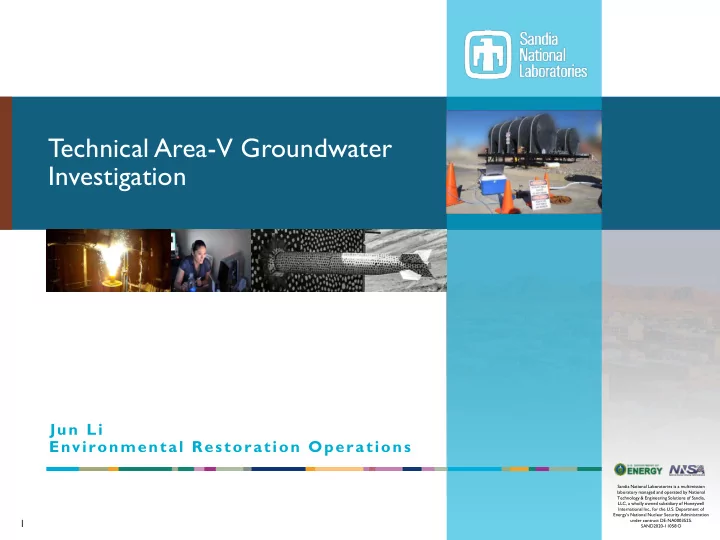

Technical Area-V Groundwater Investigation Jun Li Environmental Restoration Operations Sandia National Laboratories is a multimission laboratory managed and operated by National Technology & Engineering Solutions of Sandia, LLC, a wholly owned subsidiary of Honeywell International Inc., for the U.S. Department of Energy’s National Nuclear Security Administration 1 under contract DE-NA0003525. SAND2020-11058 O
TA-V Groundwater Area of Concern Site Description 2 ▪ TA-V Groundwater Area of Concern (AOC) is located at Sandia National Laboratories (SNL) Technical Area-V (TA-V). ▪ TA-V covers 35 acres. ▪ TA-V is an industrial area in the west-central portion on Kirtland Air Force Base (KAFB). ▪ SNL activities at TA-V began in 1961 and involve operating research reactors. ▪ Corrective action is required only for the groundwater at TA-V. TA-V Groundwater ▪ Groundwater occurs Area of Concern approximately 500 feet below the ground surface at TA-V.
TA-V Groundwater Monitoring 3 ▪ Groundwater monitoring began in 1992. ▪ Current monitoring network consists of 18 wells. ▪ Groundwater is contaminated with nitrate and trichloroethene at concentrations above the U.S. Environmental Protection Agency maximum contaminant levels (MCLs) for drinking water. ▪ The nitrate plume covers approximately 1.4 acres. ▪ The trichloroethene plume covers approximately 13 acres. ▪ No other constituents in groundwater exceed the MCLs. ▪ Neither plume is moving beyond the current area. ▪ The groundwater in this area is not used for any purpose. ▪ The nearest downgradient drinking-water supply well (KAFB-4) is 2.7 miles to the north. ▪ The plumes are not adversely impacting human health and the environment. Constituent of Maximum Concentration in 2019 MCL Concern Nitrate 15.3 milligrams per liter (well TAV-MW10) 10 milligrams per liter Trichloroethene 20.2 micrograms per liter (well LWDS-MW1) 5 micrograms per liter
Conceptual Model of Groundwater Contamination Process 4 at TA-V
Treatability Study: In-Situ Bioremediation 5 ▪ The objective is to evaluate the effectiveness of in-situ bioremediation as a potential technology for remediation of the TA-V Groundwater AOC. ▪ “In - situ” means treating the contamination in place (in the aquifer sediments). ▪ “Bioremediation” means using biological processes (bacteria) to remediate the groundwater by degrading the nitrate and trichloroethene to levels below drinking water standards. ▪ The plan of the treatability study is to deliver bioremediation solution using one injection well first and possibly up to three injection wells. ▪ The New Mexico Environment Department (NMED) Hazardous Waste Bureau (HWB) is the regulator for the investigation. ▪ Sandia has obtained the Discharge Permit DP-1845 from the NMED Ground Water Quality Bureau (GWQB) to use up to three injection wells to deliver bioremediation solution. ▪ Progress on the treatability study is provided to the NMED HWB and GWQB through quarterly reporting.
Conceptual Model of In-Situ Bioremediation Process 6
In-Situ Bioremediation Treatability Study at TA-V 7 ▪ Question to be answered: How large an area can be treated by the bioremediation solution injected? ▪ Groundwater at TA-V is aerobic and biodegradation is not naturally occurring. ▪ Bioremediation solution provides the nutrients and pH buffer for the bacteria to biodegrade nitrate and trichloroethene. ▪ Treatability Study at the first Injection Well TAV-INJ1 ▪ Injected approximately 531,000 gallons of bioremediation solution mixed with 123 liters of trichloroethene-degrading bacteria. ▪ The solution was injected from November 2018 through April 2019. ▪ Injection well TAV-INJ1 and monitoring well TAV-MW6 are monitored for the performance of in-situ bioremediation. ▪ One deep well and eight surrounding wells are being monitored to determine potential impact on groundwater quality caused by the bioremediation solution.
Findings of Treatability Study at Injection Well TAV-INJ1 8 ▪ Groundwater at injection well TAV-INJ1 has been maintaining optimal conditions for biodegradation. ▪ The inert tracer (bromide) injected with the bioremediation solution has reached monitoring well TAV-MW6. ▪ Dissolved oxygen level has decreased in the groundwater at well TAV-MW6; however, anaerobic condition is not established. ▪ No change in groundwater quality has been observed in the deep monitoring well and the eight surrounding wells. ▪ Delivery of bioremediation solution was limited by low hydraulic conductivities of the aquifer at TA-V. ▪ Infrastructure at TA-V limits installation of multiple injection wells for the success of the ISB technology across the entire lateral extent of the nitrate and TCE plumes. ▪ Findings of the treatability study of in-situ bioremediation at injection well TAV-INJ1 were shared with NMED HWB in September 2020.
Recommend
More recommend